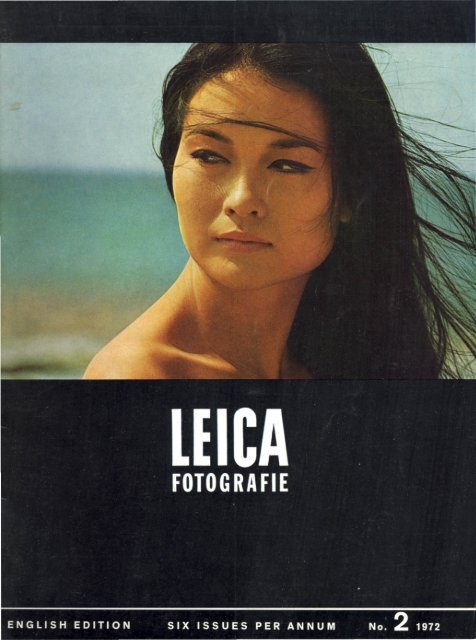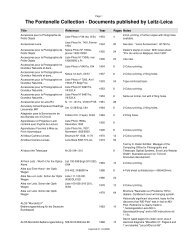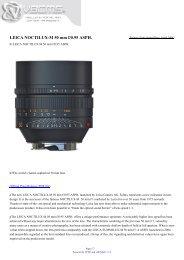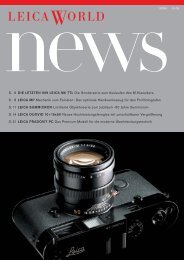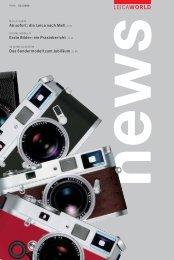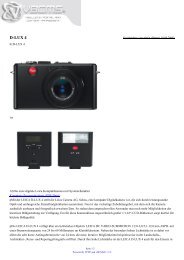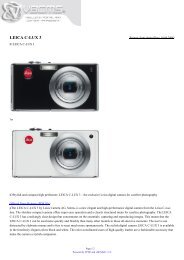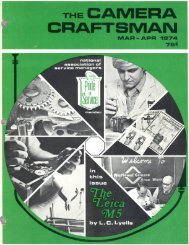Exposure determination with the Leica M 5 - Leica User Forum
Exposure determination with the Leica M 5 - Leica User Forum
Exposure determination with the Leica M 5 - Leica User Forum
Create successful ePaper yourself
Turn your PDF publications into a flip-book with our unique Google optimized e-Paper software.
<strong>Exposure</strong> <strong>determination</strong> <strong>with</strong> <strong>the</strong> <strong>Leica</strong> M 5<br />
By D. Brückner and K. D. Schaefer<br />
The latest addition to <strong>the</strong> <strong>Leica</strong> family, <strong>the</strong> new M 5,<br />
differs notably, in <strong>the</strong> way it measures exposure, not<br />
only fram <strong>the</strong> earlier <strong>Leica</strong> models, but also from all<br />
o<strong>the</strong>r rangefinder cameras. In a word, it is <strong>the</strong> first<br />
rangefinder camera to utilize <strong>the</strong> principle of selective<br />
exposure <strong>determination</strong> through <strong>the</strong> camera lens in<br />
which <strong>the</strong> selected exposure value can be seen in <strong>the</strong><br />
viewfinder. Over and above this, <strong>the</strong> new <strong>Leica</strong> offers<br />
<strong>the</strong> facility, so greatly appreciated already in <strong>the</strong> <strong>Leica</strong>flex,<br />
of being able to make a measurement on a selected<br />
area of <strong>the</strong> subject, taking into account filter factors and<br />
camera extension exposure increase factors, <strong>with</strong>out<br />
taking <strong>the</strong> camera from <strong>the</strong> eye.<br />
The photocell<br />
The secret of <strong>the</strong> <strong>Leica</strong> M 5 lies in <strong>the</strong> use of a small,<br />
movable photoresistor which swings into <strong>the</strong> light beam<br />
as <strong>the</strong> shutter is wound and measures <strong>the</strong> light intensity<br />
falling on <strong>the</strong> film from immediately in front of <strong>the</strong><br />
shutter. When <strong>the</strong> release is pressed <strong>the</strong> photocell is<br />
instantaneously swung out of <strong>the</strong> light path before <strong>the</strong><br />
shutter operates. The same thing happens when <strong>the</strong><br />
lens is removed, as a precaution against possible damage<br />
to <strong>the</strong> metering system. In order to obtain <strong>the</strong> picture<br />
This location of <strong>the</strong> photocell immediately in front of<br />
<strong>the</strong> shutter, i.e. between lens and film plane, is unfortunately<br />
not an ideal arrangement from <strong>the</strong> optical<br />
point of view. As can be seen from <strong>the</strong> diagram in<br />
Lene<br />
Fig.2a<br />
Fig.2b<br />
Fig.2:<br />
lens<br />
Film plane<br />
Y'<br />
E<br />
{.<br />
overecrn '0'. !<br />
t Measuring<br />
field<br />
t1 -~~!1<br />
- - -- -- - --<br />
PhotOfesistOf<br />
Film plane<br />
Effect of position of exit pupil on meter indication.<br />
y'<br />
1<br />
Fig.1<br />
shown in Fig. 1 which illustrates <strong>the</strong> arrangement of <strong>the</strong><br />
photocell in <strong>the</strong> camera, <strong>the</strong> swing out was operated by<br />
inserting a bayonet adapter. In addition, to show it up<br />
more clearly, a piece of light grey card was inserted in<br />
piace of <strong>the</strong> black cloth of <strong>the</strong> focal plane shutter. Normally,<br />
<strong>the</strong> photocell is not visible when <strong>the</strong> lens is removed.<br />
Fig. 2a, on <strong>the</strong> one hand, quite an appreciable proportion<br />
of <strong>the</strong> image-forming light outside <strong>the</strong> measuring field<br />
actually falls on <strong>the</strong> photocell, <strong>the</strong>reby reducing <strong>the</strong> degree<br />
of selectivity; on <strong>the</strong> o<strong>the</strong>r hand-and this is an<br />
even more serious matter-<strong>the</strong> exposure <strong>determination</strong><br />
becomes <strong>the</strong>reby appreciably dependent upon <strong>the</strong> focal<br />
length, <strong>the</strong> stop in use, and <strong>the</strong> design of <strong>the</strong> lens. Fig.<br />
2a shows how <strong>the</strong> photocell receives an excess of light<br />
fram areas outside <strong>the</strong> actual measuring field which increases<br />
<strong>with</strong> <strong>the</strong> size of <strong>the</strong> stop used, and <strong>with</strong> decreasing<br />
lens focal length, or-more precisely-<strong>with</strong><br />
increase in size of wh at is termed <strong>the</strong> exit pupil and its<br />
nearer approach to <strong>the</strong> film plane. Since however <strong>the</strong><br />
required exposure value is calculated from <strong>the</strong> ratio of<br />
<strong>the</strong> intensity of <strong>the</strong> incident light and <strong>the</strong> size of <strong>the</strong><br />
measuring field, as <strong>the</strong> focallength of <strong>the</strong> lens decreases<br />
and <strong>the</strong> relative aperture increases, <strong>the</strong> meter indication<br />
tends more and more to result in underexposure. This<br />
is shown graphically in Fig. 3, for aseries of <strong>Leica</strong> lenses,<br />
by <strong>the</strong> dotted line.<br />
72
+,<br />
<strong>Exposure</strong> meter errOf (in light values)<br />
',5<br />
0,5<br />
0,5 ,-<br />
/'<br />
Fig.3<br />
/<br />
I<br />
',5 50<br />
/<br />
---'<br />
Photoresistor <strong>with</strong> annular diaphragm<br />
- - - - Photoresistor <strong>with</strong>out annular diaphragm<br />
100 150<br />
Position of exlt pupil (mm)<br />
Starting from a standard 50 mm f/2 lens, this curve<br />
shows that at longer focal lengths overexposure reaches<br />
a maximum of half a stop, whilst <strong>the</strong> use of extremely<br />
short focus lenses may result in as much as a whole stop<br />
underexposure. This means that if no additional precautions<br />
were taken only lenses between about 35 and<br />
90 mm focus could be employed, while it must also be<br />
borne in mind that <strong>the</strong> effect on accuracy<br />
of exposure<br />
<strong>determination</strong> rapidly falls off <strong>with</strong> stopping down or<br />
increased camera extension in close-up work, and in<br />
<strong>the</strong> macro range.<br />
was <strong>the</strong> more difficult of solution in that it had so far<br />
as possible to cover all Leitz lenses-even those of older<br />
design.<br />
In <strong>the</strong> end a surprisingly simple solution was arrived<br />
at in <strong>the</strong> shape of an annular venetian blind form of diaphragm<br />
placed directly in front of <strong>the</strong> photocell as can<br />
be seen clearly in <strong>the</strong> sectional view in Fig. 4 behind <strong>the</strong><br />
dust-proof plate. The effect of this arrangement is shown<br />
diagrammatically in Fig. 5, and rests upon <strong>the</strong> fact that<br />
<strong>the</strong> light which enters under conditions of excessively<br />
wide angle, and which would o<strong>the</strong>rwise result in false<br />
indications, is blocked by <strong>the</strong> depth of <strong>the</strong> venetian slats,<br />
and so prevented from reaching <strong>the</strong> photoresistor. The<br />
separation and dimensions of <strong>the</strong> diaphragm elements<br />
are so designed that residual exposure errors, over <strong>the</strong><br />
entire lens programme of <strong>the</strong> <strong>Leica</strong> system, is less than<br />
Lens<br />
Film plane<br />
Fig. Sa<br />
Correction at all focal lengths<br />
Since any possibility of a lateral arrangement of <strong>the</strong><br />
photocell, wherein <strong>the</strong> measuring beam is reflected out<br />
of <strong>the</strong> image forming beam as in <strong>the</strong> <strong>Leica</strong>flex, was ruled<br />
out on grounds of space because of <strong>the</strong> considerably<br />
smaller dimensions of <strong>the</strong> <strong>Leica</strong>, o<strong>the</strong>r means had to be<br />
sought to reduce <strong>the</strong> unavoidable measurement errors<br />
inherent in this design of <strong>the</strong> meter system to <strong>the</strong> point<br />
where <strong>the</strong>y could in practice be neglected. This problem<br />
Photoresistor<br />
<strong>with</strong> annular<br />
dlaphragm<br />
Fig. Sb<br />
Lene<br />
Film plane<br />
Fig.4<br />
Fig.5:<br />
Vignetting of individual beams of light by annular<br />
diaphragm in front of <strong>the</strong> photoresistor.<br />
half a stop. and can accordingly be neglected in comparison<br />
<strong>with</strong> <strong>the</strong> effects of variations of film speed and<br />
of development conditions. This likewise is illustrated<br />
graphically by one of <strong>the</strong> curves in Fig. 3,<br />
This device ensures accuracy of exposure <strong>determination</strong><br />
<strong>with</strong> all <strong>Leica</strong> lensss. But <strong>the</strong>re is one exception:<br />
those lenses wh ich penetrate so deeply into <strong>the</strong> camera<br />
body that <strong>the</strong>y prevent <strong>the</strong> movement of <strong>the</strong> photocell.<br />
In <strong>the</strong> case of such collapsible lenses a spacing collar<br />
73
considerable range, and leaves little to be desired. Thus<br />
<strong>the</strong> bathing enthusiast can capture any pretty nymph on<br />
his film in <strong>the</strong> most brilliant midday sunshine, while in <strong>the</strong><br />
evening, at <strong>the</strong>atre or restaurant, he can equally safely<br />
measure exposure and take his snapshots-so long as<br />
his hand is steady enough to cope <strong>with</strong> <strong>the</strong> relatively<br />
slow shutter speeds that will be called for.<br />
Fig.6<br />
must be provided to limit <strong>the</strong> collapsing movement to <strong>the</strong><br />
permissible amount (see <strong>Leica</strong>- Fotografie No. 6/71,<br />
p.249).<br />
Practical application<br />
How, in practice, is <strong>the</strong> exposure determined <strong>with</strong> <strong>the</strong><br />
M 5? Operating <strong>the</strong> film transport lever winds on <strong>the</strong> film<br />
and tensions <strong>the</strong> shutter, and simultaneously switches<br />
on <strong>the</strong> meter circuit, which is powered by a small<br />
HgO battery. In <strong>the</strong> viewfinder will now be seen, beneath<br />
<strong>the</strong> actual picture image, <strong>the</strong> shutter speed at which <strong>the</strong><br />
camera is at <strong>the</strong> moment set (e.g. 250 = '/250 sec.)<br />
and a bright band over wh ich moves <strong>the</strong> pointer of <strong>the</strong><br />
built-in exposure meter (see Fig. 6). As <strong>the</strong> iris diaphragm<br />
is adjusted, <strong>the</strong> pointer alters in position, and<br />
as <strong>the</strong> shutter speed is varied <strong>the</strong> index line moves along<br />
<strong>the</strong> light band. Sy joint adjustment of both stop and<br />
shutter speed, <strong>the</strong> pointer and index must be brought<br />
into coincidence on <strong>the</strong> light band to ensure accurate<br />
setting of exposure. At <strong>the</strong> same time <strong>the</strong> position of<br />
this intersection on <strong>the</strong> light band affords a qualitative<br />
indication of <strong>the</strong> aperture in use.<br />
As <strong>the</strong> aperture is opened up, <strong>the</strong> intersection moves<br />
to <strong>the</strong> right; on closing down, to <strong>the</strong> left, as indicated by<br />
<strong>the</strong> semi-circular symbols of different sizes at <strong>the</strong> two<br />
ends of <strong>the</strong> light band.<br />
The field under measurement by <strong>the</strong> exposure meter<br />
is automatically reflected into <strong>the</strong> finder for all focal<br />
lengths frorn 28 to 135 mm. In Fig. 6 for example (showing<br />
<strong>the</strong> viewfinder field <strong>with</strong> 50 mm lens mounted in<br />
<strong>the</strong> camera) <strong>the</strong> acceptance angle is indicated by <strong>the</strong><br />
curved marks at <strong>the</strong> four corners around <strong>the</strong> focusing<br />
field.<br />
Sensitivity<br />
To return once more to <strong>the</strong> technical data: <strong>the</strong> range<br />
of <strong>the</strong> meter is from 200,000 asb to 0.4 asb. This is a very<br />
There is one special aspect which needs to be stressed:<br />
it frequently happens that, say, a white house is photographed<br />
in glaring sunshine and in accordance <strong>with</strong> <strong>the</strong><br />
meter indication comes out in <strong>the</strong> transparency a medium<br />
grey. Similarly a picture which often finishes up<br />
in <strong>the</strong> waste paper basket is that of some black object.<br />
Here again, because <strong>the</strong> measurement has been made<br />
on <strong>the</strong> object itself and <strong>the</strong> exposure made accordingly,<br />
<strong>the</strong> subject<br />
comes out grey instead of black. The evidence<br />
in each case would<br />
seem to point to <strong>the</strong> exposure<br />
meter giving "qrev" results, even though <strong>the</strong> photographer<br />
is satisfied that <strong>the</strong> measurement was correctly<br />
made. The natural conclusion to be drawn is that since<br />
all <strong>the</strong> o<strong>the</strong>r pictures taken seem more or less satisfactory<br />
<strong>the</strong> fault must lie <strong>with</strong> <strong>the</strong> exposure meter. This is not so.<br />
All <strong>the</strong> meter has done is to make us aware of an error in<br />
our own<br />
procedure. We have in fact not taken account<br />
of <strong>the</strong> assumption made, in calibrating all exposure meters,<br />
as to <strong>the</strong> distribution<br />
of light and dark areas in <strong>the</strong><br />
normal subject; i.e. that every subject on <strong>the</strong> average<br />
reflects 17% of <strong>the</strong> light which falls upon it. This proportion<br />
results in a medium grey tone rendering. Kodak<br />
do in fact supply a standard grey card <strong>with</strong> just this<br />
reflection factor.<br />
<strong>Exposure</strong> meters are all calibrated to <strong>the</strong> same standard:<br />
i.e. <strong>the</strong>y all give <strong>the</strong> same exposure indication for<br />
any given subject luminosity. To ensure this, <strong>the</strong> calibration<br />
conditions have been standardized. Naturally,<br />
as soon as we are confronted <strong>with</strong> a subject which departs<br />
palpably from <strong>the</strong>se standard conditions, <strong>the</strong> response<br />
of <strong>the</strong> meter must be manually compensated. We<br />
can ei<strong>the</strong>r make a correction to <strong>the</strong> exposure as indicated<br />
by <strong>the</strong> meter, or alternatively in making <strong>the</strong> measurement<br />
we can direct <strong>the</strong> meter on to so me object which<br />
exhibits <strong>the</strong> standard reflection characterisitic while receiving<br />
<strong>the</strong> same level of illumination as <strong>the</strong> subject we<br />
wish to photograph.<br />
In making a measurement, always bear in mind what<br />
it is that you are actually wanting to measure. The exposure<br />
meter cannot be expected to know what you<br />
have in mind. It merely measures whatever light is reflected<br />
from <strong>the</strong> subject and enters <strong>the</strong> camera lens. In<br />
terms of <strong>the</strong> <strong>Leica</strong> M 5 this means: Take special note of<br />
<strong>the</strong> area of <strong>the</strong> subject which is included in <strong>the</strong> exposure<br />
measurement field of <strong>the</strong> viewefinder.<br />
74


